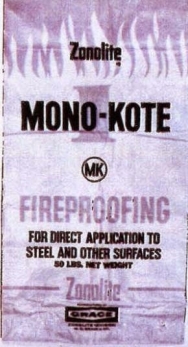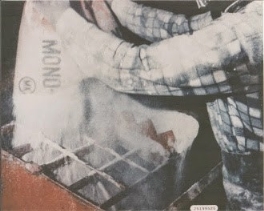WR Grace Exits Bankruptcy After 13 Years, Was it Worth the Wait? You Decide

After ducking asbestos claims for 13 years, W.R. Grace in February of this year finally emerged from Chapter 11 bankruptcy. W.R. Grace was one of the worst polluters on Earth. At the time they filed, they were facing over 100,000 personal injury and death cases, primarily stemming from the use of fireproofing and plaster products. W.R. Grace gained notoriety as the company which contaminated the tiny mountain town of Libby, Montana with tremolite asbestos from the mining of asbestos laced vermiculite.
At the time they filed, in 2001, WRG stock was around $1.50 a share. When they emerged from bankruptcy protection 13 years later, the stock was selling at $92 a share. It pays to duck responsibility? You decide.
Part of its court-approved bankruptcy reorganization plan was the establishment of two trusts to pay personal injury claimants and property owners. The trusts are funded by more than $4 billion in cash, stock warrants, insurance proceeds and other sources.

This August, the trust began accepting Proof of Claim forms. According to their Trust Distribution Procedures, (basically their instruction manual) the Scheduled Average Value for a claimant diagnosed with mesothelioma is $180,000. The value for asbestos-related lung cancer is $42,000. However, the actual payment percentage is 26% of the Scheduled Value.
A claimant is free to seek a value greater than the Scheduled Value by requesting the Trust perform an Individual Review of the claim. However, this does not guarantee a greater value or even an equal value as the Scheduled Value. The Maximum Value for this type of review for a mesothelioma claim is $450,000 before applying the liquidated payment percentage of 26%. For an asbestos-related lung cancer, the Maximum Value of an Individual Review claim is $95,000
To qualify for payment, a claimant must provide credible medical and exposure evidence as defined in the instruction manual (TDP).
The claims are paid on an impartial first-in-first-out basis.
Now, if a claimant was unfortunate enough to have filed a claim prior to April 2, 2001 against WRG as a part of a lawsuit but was never paid, they would have to follow the conditions outlined in the TDP, but the claim would be reviewed sooner.
The WRG bankruptcy is the longest in a long line of bankruptcies filed by the asbestos superpowers. It's a sordid tale, and a long and desolate trail, but for those with the stomach, and the patience, here's a timeline. As they say, justice delayed is justice denied. What do you think? Will MBA students be studying the WRG bankruptcy as an example of what not to do in corporate america? Or will they be looking at it as a brilliant business move that saved the company billions and enriched thousands of shareholders?
You decide.
- In April of 2001, WRG is named in more than 325,000 asbestos-related personal injury lawsuits. They soon announce they have filed for voluntary Chapter 11 bankruptcy protection.
- In May of 2001, WRG gets approval from the U.S. Bankruptcy Court to receive a $250 million loan from Bank of America, to help support operations.
- In February of 2003, WRG asks the U.S. Bankruptcy Court to allow an extension of its $250 million loan agreement with Bank of America for another three years.
- In October of 2004, WRG makes a request to delay filing a reorganization plan, hoping to continue negotiations with creditors. WRG also is notified they are a target of a federal grand jury investigation, facing indictments on several charges including interfering with an EPA investigation, violating the Clean Air Act and placing asbestos materials in schools and local residences and conspiring to conceal the resulting health problems.
- In November of 2004, WRG files a reorganization plan with a Delaware court which is soon approved.
- In January of 2005, WRG files an amended bankruptcy protection plan with a Delaware court.
- In September of 2005, WRG opens a new China headquarters in Shanghai, which consolidates four other offices in the country.
- In December of 2005, WRG announces they have spent $20 million in the year 2005 on legal defense costs.
- In February of 2006, WRG announces it will open a new manufacturing facility, costing $20 million, in Mt. Pleasant, Tennessee.
- In April of 2008, WRG reaches a tentative settlement on all current and future asbestos-related claims, worth $2 billion.
- In January of 2011, WRG latest bankruptcy reorganization plan is approved by Judge Judith Fitzgerald in Wilmington, Delaware.
- In January of 2012, WRG’s bankruptcy reorganization plan is approved by a judge of the U.S. District Court.
- In November of 2012, WRG announces it will pay cash, not stock, to settle a larger share of the asbestos-related injury claims against the company.
- In December of 2012, WRG announces its total payments to date with its bank lenders, including interest is at $1.1 billion dollars.
- In February of 2014, WRG emerges from bankruptcy protection.
The Wall Street Journal provided an excellent WRG trip summary.
WSJ highlights:
- The original bankruptcy judge, Alfred Wolin, was ordered off the case under fire from distressed-debt investors who fretted he was too friendly with the asbestos plaintiff’s camp.
- A criminal indictment of the company and some executives, accused of knowingly allowing dangerous asbestos contamination to spread. WRG and its executives beat the charges, after a trial before a jury in Montana.
- Some dark comedy, such as the asbestos-disposal solution WRG pursued for years in a Minneapolis neighborhood: Advertise asbestos-contaminated material as “free crushed rock” and invite the neighbors to come haul it away to decorate their lawns, firm up their driveways. WRG cleaned up the contamination.
Was it all worth it? Earlier this month, WRG showed off its new 90,000-square-foot global headquarters building along with several laboratories at its 160-acre Columbia, Maryland campus.
You decide.


